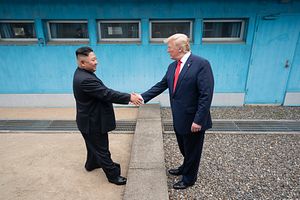The dramatic summitry that took place on June 30 in the demilitarized zone (DMZ) separating the two Koreas is the latest sign that North Korea’s transition to a “normal country” is on track. Coming in the 30th anniversary year of the fall of the Berlin Wall, the events of June 30 may go down in history as a watershed moment in the process marking the end of the Cold War in the Korean peninsula.
What was most significant about the meetings between the leaders of the two Koreas and the United States was that they psychologically and symbolically dismantled the decades-old division of the Korean peninsula. The DMZ, still the most heavily militarized border in the world, used to be so fraught with tension that visiting U.S. presidents called it “the scariest place on earth.” On June 30, millions of people in the two Koreas and many others around the world watched on live television as U.S. President Donald Trump and North Korean Chairman Kim Jong Un freely walked across the DMZ together. South Korean President Moon Jae-in later joined their company, all three men wearing smiles and effusively praising one another. This was a historical moment reminiscent of November 9, 1989, when East Berliners spontaneously and joyfully walked across the Berlin Wall, toppling the most visible symbol of the Iron Curtain. Like on November 9, 1989, developments on June 30 unfolded in a spontaneous fashion — sparked by a tweet from Trump — rather than by a scripted plan made long in advance. The three-way “summitry” in the DMZ was hastily put together and transpired within 24 hours after that tweet.
The psychological impact of watching a sitting president of the United States walking across the DMZ with North Korea’s supreme leader in a gesture of peace must have been especially acute in North Korea. For decades, North Koreans have been indoctrinated into regarding the U.S. as their mortal enemy, responsible for the division of the peninsula and the levelling of their cities during the Korean War. However, on June 30, millions of North Korean viewers watching the extensive North Korean state television news coverage of the events that day got the unmistakable message that the United States is now their friend and partner in a new era of peace and co-prosperity. Hereon, it will not be easy for the North Koreans to revert fully to their old ways of vilifying the United States as the evil empire bent on their destruction.
The events on June 30 demonstrated that the lack of rapid progress on denuclearization and apparent setbacks in U.S.-North Korean relations since the Hanoi Summit have not damaged the personal relationship between Trump and Kim. They also showed that this personal relationship is now the driving force behind U.S.-North Korea relations and can inject new momentum into stalled denuclearization talks. As Washington and Pyongyang prepare now to restart working-level talks on denuclearization, the global community needs to be patiently supportive. Even with good personal relations between Trump and Kim, inducing North Korea’s denuclearization will be treacherously difficult. A creative framework of incentives and safeguards is necessary to assure Pyongyang that denuclearization will enhance, not diminish, its security. At the same time, the global community must engage and encourage North Korea in its transition to a “normal country.”
Jongsoo Lee is Senior Managing Director at Brock Securities LLC and Center Associate at Harvard University’s Davis Center for Russian and Eurasian Studies. The opinions expressed in this piece are solely his own. He can be followed on Twitter at @jameslee004.
































